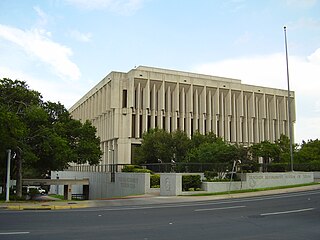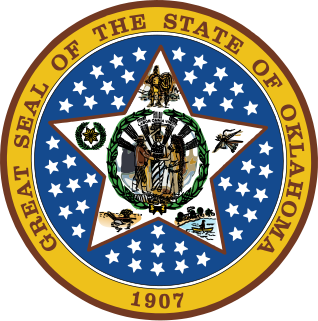
A pension is a fund into which a sum of money is added during an employee's employment years and from which payments are drawn to support the person's retirement from work in the form of periodic payments. A pension may be a "defined benefit plan", where a fixed sum is paid regularly to a person, or a "defined contribution plan", under which a fixed sum is invested that then becomes available at retirement age. Pensions should not be confused with severance pay; the former is usually paid in regular amounts for life after retirement, while the latter is typically paid as a fixed amount after involuntary termination of employment before retirement.
A pension fund, also known as a superannuation fund in some countries, is any plan, fund, or scheme which provides retirement income.

The California Public Employees' Retirement System (CalPERS) is an agency in the California executive branch that "manages pension and health benefits for more than 1.6 million California public employees, retirees, and their families". In fiscal year 2019–20, CalPERS paid over $25.8 billion in retirement benefits, and over $9.2 billion in health benefits.

The State of New Hampshire has a republican form of government modeled after the Government of the United States, with three branches: the executive, consisting of the Governor of New Hampshire and the other elected constitutional officers; the legislative, called the New Hampshire General Court, which includes the Senate and the House of Representatives; and the judicial, consisting of the Supreme Court of New Hampshire and lower courts.
In Australia, superannuation or just super is the term for retirement pension benefit funds. Employees pay deductions from their wage or salary and employers make similar regular contributions. Most employees contribute to large funds, either industry funds run jointly by unions and employers, or retail funds managed by financial institutions. More than a million Australians have a self-managed superannuation fund.
Pensions in the United States consist of the Social Security system, public employees retirement systems, as well as various private pension plans offered by employers, insurance companies, and unions.
The Illinois Municipal Retirement Fund is the second largest and best-funded public pension system in Illinois. Since 1941, has partnered with local units of government to provide retirement, disability and death benefits for public employees. With a funded status of about 94 percent and more than $50 billion in assets, IMRF is well-funded and sustainable.
In the United States, public sector pensions are offered at the federal, state, and local levels of government. They are available to most, but not all, public sector employees. These employer contributions to these plans typically vest after some period of time, e.g. 5 years of service. These plans may be defined-benefit or defined-contribution pension plans, but the former have been most widely used by public agencies in the U.S. throughout the late twentieth century. Some local governments do not offer defined-benefit pensions but may offer a defined contribution plan. In many states, public employee pension plans are known as Public Employee Retirement Systems (PERS).

The Public Employees Retirement System (PERS) is the retirement and disability fund for public employees in the U.S. state of Oregon established in 1946. Employees of the state, school districts, and local governments are eligible for coverage. A health insurance plan for covered retirees was added to the program in 1987. The program is administered by a twelve-member board of trustees, appointed to three-year terms by the Governor subject to confirmation by the Senate, which also administers the Oregon Savings Growth Plan, a voluntary deferred compensation plan established in 1991.
Diann Shipione is a former trustee of the San Diego, California City Employees' Retirement System pension board, credited with exposing unlawful underfunding of the pension fund and omissions in municipal bond sales documents. She was formerly a vice president at UBS Financial Services and is the wife of businessman Patrick C. Shea.

The California State Teachers' Retirement System (CalSTRS) provides retirement, disability and survivor benefits for California's 965,000 prekindergarten through community college educators and their families. CalSTRS was established by law in 1913 and is part of the State of California's Government Operations Agency. As of September 2020, CalSTRS is the largest teachers' retirement fund in the United States. CalSTRS is also currently the eleventh largest public pension fund in the world. As of October 31, 2020, CalSTRS managed a portfolio worth $254.7 billion.

Teacher Retirement System of Texas (TRS) is a public pension plan of the State of Texas. Established in 1937, TRS provides retirement and related benefits for those employed by the public schools, colleges, and universities supported by the State of Texas and manages a $180 billion trust fund established to finance member benefits. More than 1.6 million public education and higher education employees and retirees participate in the system. TRS is the largest public retirement system in Texas in both membership and assets and the sixth largest public pension fund in America. The agency is headquartered at 1000 Red River Street in the capital city of Austin.

A defined benefit (DB) pension plan is a type of pension plan in which an employer/sponsor promises a specified pension payment, lump-sum or combination thereof on retirement that is predetermined by a formula based on the employee's earnings history, tenure of service and age, rather than depending directly on individual investment returns. Traditionally, many governmental and public entities, as well as a large number of corporations, provide defined benefit plans, sometimes as a means of compensating workers in lieu of increased pay.
The statutory and fiduciary mandate of the State Board of Administration of Florida (SBA) is to invest, manage and safeguard assets of the Florida Retirement System (FRS) Trust Fund as well as the assets of a variety of other funds. The SBA manages 25 different investment funds and trust clients.

The Oklahoma Firefighters Pension and Retirement System (OFPRS) is an agency of the government of Oklahoma that manages the public pension system for firefighters in Oklahoma. The System provides pension benefits such as normal retirement, disability retirement, surviving spouse benefits and a death benefit.

The Oklahoma Police Pension and Retirement System (OPPRS) is an agency of the government of Oklahoma that manages the public pension system for municipal police officers in Oklahoma. The System provides pension benefits such as normal retirement, disability retirement, surviving spouse benefits and a death benefit.

The Oklahoma Public Employees Retirement System (OPERS) is an agency of the government of Oklahoma that manages the public pension system for majority of Oklahoma state employees. 74 Okla.Statutes §§901 et seq. The System provides pension benefits such as normal retirement, disability retirement, surviving spouse benefits and a death benefit.
Oklahoma Teacher's Retirement System (OTRS) is the pension program for public education employees in the State of Oklahoma. As of June 30, 2014, the program had nearly 168,000 members. Public education teachers and administrators are required to be OTRS members; support staff can join voluntarily. State law established OTRS in 1943 to manage retirement funds and provide financial security for public education employees. Its first checks to retirees were sent out in 1947. It is administered by a staff and 14-member board of trustees. Its current Executive Director is Tom Spencer who started in that position on November 1, 2014.
Utah Retirement Systems administers pension plans and retirement savings plans for public employees in the U.S. state of Utah. There are eight separate defined-benefit pension plans administered by URS, as well as various retirement savings plans. As of December 31, 2014, the URS was managing over $31 billion in its pension trust funds, for nearly 200,000 members. Besides the pension trust funds, the URS manages a 401(k), 457(b), a traditional IRA and Roth IRA with around $4.5 billion in assets combined at the end of 2014.
Indiana Public Retirement System (INPRS) is a U.S.-based pension fund responsible for the pension assets for public employees in the state of Indiana. INPRS is among the largest 100 pension funds in the United States, with $48.910 billion in actuarial accrued liabilities and $37.729 billion in actuarial assets as of June 30, 2017. The fund administers and manages several pension funds in the State of Indiana, the two largest of which are the Indiana State Teachers' Retirement Fund and the Indiana Public Employees' Retirement Fund. The others are the 1977 Police Officers' and Firefighters' Retirement Fund; the Judges' Retirement System; the Excise, Gaming, and Conservation Officers' Retirement Fund; the Prosecuting Attorneys' Retirement Fund; the Legislators' Defined Benefit Fund; and the Legislators' Defined Contribution Fund. Each of the current funds remains separate but administered by the nine-member board of trustees of INPRS.







